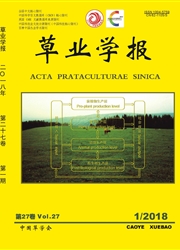

 中文摘要:
中文摘要:
本文以藏北地区为研究区域,基于归一化植被指数(NDVI)反演草地植被盖度,以植被盖度作为判断草地退化的标准,综合计算藏北地区2000-2010年逐年草地退化指数(grassland degradation index),定量揭示藏北地区草地退化的时空分布规律。结果表明,截至2010年,藏北地区草地退化现状仍然较为严重,退化草地的面积占全区面积的58.2%。其中,重度退化和极重度退化草地面积的比例分别为19.0%和6.5%,区域草地退化指数为1.97,接近中等退化水平。分区结果显示,藏北地区中部、东部、北部草地退化情况较为严重,均处于中等退化等级,西部地区的退化情况最轻,处于轻度退化等级。分析2000-2010年藏北地区全区及各个分区的草地退化趋势表明,只有北部地区有减缓趋势;2000-2010年间与1981-1985年间对比结果显示,重度退化及极重度退化草地面积比例上升幅度较大。2000-2010年间藏北地区平均草地退化指数为1.84,草地退化等级在轻度退化到中度退化之间波动。
 英文摘要:
英文摘要:
An expansive alpine grassland ecosystem dominates the landscape in Northern Tibet,and the status of this grassland has significant implications for the major Asian rivers,and for the climate and eco-environ-ment of Tibet and the wider region.The harsh natural environment and fragile ecosystem,together with in-creasing frequency and intensity of human activities such as pastoralism,and climate change,have resulted in increasing reports of degradation of the grassland ecosystem.We used vegetation cover as main indicator of eco-system health,and with remote sensing monitoring,calculated the grassland degradation index (GDI)and e-valuated grassland degradation in Northern Tibet from 2000 to 2010.The analysis was based on the Normalized Differential Vegetation Index (NDVI)data from the Advanced Very High-Resolution Radiometer (AVHRR) with a spatial resolution of 8 km from 1981 to 1985 and from Moderate Resolution Imaging Spectroradiometer (MODIS)with a spatial resolution of 0.25 km of 2000-2010.Then,we have analyzed the temporal and spatial distribution of grassland degradation in Northern Tibet from 2000 to 2010.It was found that grassland degra-dation in Northern Tibet was still severe.The GDI was 1.97 in 2010,near to seriously degraded status.The extremely seriously degraded and seriously degraded categories occupied 6.5% and 19.0% of the study area, respectively.The moderately and slightly degraded grassland categories accounted for 15.1% and 12.1%,re-spectively.Undegraded grassland occupied 41.8% of the total grassland area in 2010.The extent of extremely seriously degraded and seriously degraded categories was greatly increased in the data from 2000-2010,com-pared with the period from 1981 -1985.However,the increase in grassland degradation in Northern Tibet from 2000 to 2010 was slight,with the mean value of the GDI being 1.84 in 2010,representing a change from light degradation to moderate degradation in Northern Tibet from 2000 to 2010.
 同期刊论文项目
同期刊论文项目
 同项目期刊论文
同项目期刊论文
 Effects of topography and human activity on the net primary productivity (NPP) of alpine grassland i
Effects of topography and human activity on the net primary productivity (NPP) of alpine grassland i Challenges in disentangling the influence of climatic and socio-economic factors on alpine grassland
Challenges in disentangling the influence of climatic and socio-economic factors on alpine grassland Effects of grazing bylarge herbivores on plant diversity and productivity of semi-arid alpine steppe
Effects of grazing bylarge herbivores on plant diversity and productivity of semi-arid alpine steppe Adaptation strategies of climate variability impacts on alpine grassland ecosystems in Tibetan Plate
Adaptation strategies of climate variability impacts on alpine grassland ecosystems in Tibetan Plate Change of snow cover and its impact on alpine vegetation in the source regions of large rivers on th
Change of snow cover and its impact on alpine vegetation in the source regions of large rivers on th 期刊信息
期刊信息
